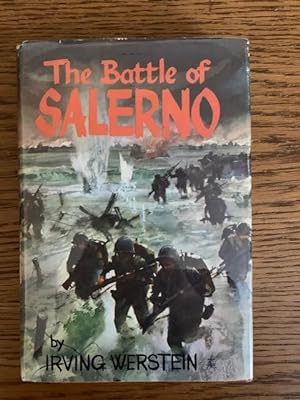The Battle of Salerno by Werstein Irving, First Edition (2 results)
Product Type
- All Product Types
- Books (2)
- Magazines & Periodicals
- Comics
- Sheet Music
- Art, Prints & Posters
- Photographs
- Maps
-
Manuscripts &
Paper Collectibles
Condition
- All Conditions
- New
- Used
Binding
- All Bindings
- Hardcover
- Softcover
Collectible Attributes
- First Edition
- Signed
- Dust Jacket (1)
- Seller-Supplied Images (1)
- Not Printed On Demand
Seller Location
Seller Rating
-
The Battle of Salerno
Published by Thomas Crowell Co., 1965
Seller: Fred M. Wacholz, Elkhart, IN, U.S.A.
Book First Edition
Hardcover. Condition: Very Good. Dust Jacket Condition: Very Good. 1st Edition. Book and unclipped DJ in clear plastic cover. Clean ex-library copy, stated 1st edition. Bright orange cover with sketch of Italy on front. Black text on tight as new spine and hinges. Very light corner scuffing. No previous owners marks. Maps by Ava Morgan. Neat DJ color picture of assault troops storming the beach under fire. Authors B+W photo on back of DJ.
-
The Battle of Salerno
Published by Thomas Y. Crowell Company, New York, 1965
Seller: Ground Zero Books, Ltd., Silver Spring, MD, U.S.A.
First Edition
Hardcover. Condition: Good. Ava Morgan (Maps) (illustrator). First Printing [Stated]. vi,[2], 151, [1] pages. The Table of Contents includes chapters on Background, Operation Avalanche, Code Word: Orkan, Operation Avalanche Assault; Operation Avalanche Ebb and Flow, followed by Brief Glossary of Military terms, Types of Aircraft at Salerno, Allied Casualties in operation avalanche, Suggested Reading, and Index. This book narrates the story of Operation Avalanche--the invasion of the Italian mainland on September 9, 1943, by Anglo-American forces. No man who fought at Salerno will ever forget the hardships, disappointment, and heartbreak of Operation Avalanche, which had been launched amid predictions of swift victory. Instead of a speedy triumph, the invasion met near disaster. One noted historian declared: "It should have been named Avalanche of Errors, not Operation Avalanche." Irving Werstein was an author of some 40 books. His experience as an infantry soldier in the Army in World War II and his work as a correspondent, for Yank Magazine had a major influence on his writing career. A careful researcher, he read the battle reports and journals of both sides, interviewed soldiers and read their letters and diaries and contemporary publications for background. He once recounted, "These young warriors are the central figures of my books." His books covered such varied conflicts as "Battle of Salerno," " "Seventeen Seventy Six: The Adventures of the American Revolution Told with Pictures," and "Ten Days in November: The Russian Revolution." In 1938 he sold a pulp magazine story for $15, an event that caused him to decide to take up free lance writing full-time. Operation Avalanche was the codename for the Allied landings near the port of Salerno, executed on 9 September 1943, part of the Allied invasion of Italy. The Italians withdrew from the war the day before the invasion, but the Allies landed in an area defended by German troops. Planned under the name Top Hat, it was supported by the deception plan Operation Boardman. The landings were carried out by the US Fifth Army, under American General Mark W. Clark. It comprised the U.S. VI Corps, the British X Corps and the US 82nd Airborne Division, a total of about nine divisions. Its primary objectives were to seize the port of Naples to ensure resupply, and to cut across to the east coast, trapping the Axis troops further south. In order to draw troops away from the landing ground, Operation Baytown was mounted. This was a landing by the British Eighth Army in Calabria in the 'toe' of Italy, on 3 September. Simultaneous sea landings were made by the British 1st Airborne Division at the port of Taranto (Operation Slapstick). British General Bernard Montgomery had predicted Baytown would be a waste of effort because it assumed the Germans would give battle in Calabria; if they failed to do so, the diversion would not work. He was proved correct. After Baytown, the Eighth Army marched 300 miles (480 km) north to the Salerno area against no opposition other than engineer obstacles. The Salerno landings were carried out without previous naval or aerial bombardment in order to achieve surprise. Surprise was not achieved. As the first wave approached the shore at Paestum a loudspeaker from the landing area proclaimed in English, "Come on in and give up. We have you covered." The troops attacked nonetheless. The Germans had established artillery and machine-gun posts and scattered tanks through the landing zones which made progress difficult, but the beach areas were captured. Around 07:00 a concerted counterattack was made by the 16th Panzer Division. It caused heavy casualties but was beaten off. Both the British and the Americans made slow progress, and still had a 10 miles (16 km) gap between them at the end of day one. They linked up by the end of day two and occupied 35-45 miles of coastline to a depth of 6-7 miles. Over 12-14 September the Germans organized a concerted counterattack by six divisions of motorized troops, hoping to throw the Salerno beachhead into.



